
Exhibit 99.4 James Hardie Systems Steven Terzian, General Manager JHS Asia Pacific Investor and Analyst Tour Sunshine Coast, Australia June 25-26, 2018
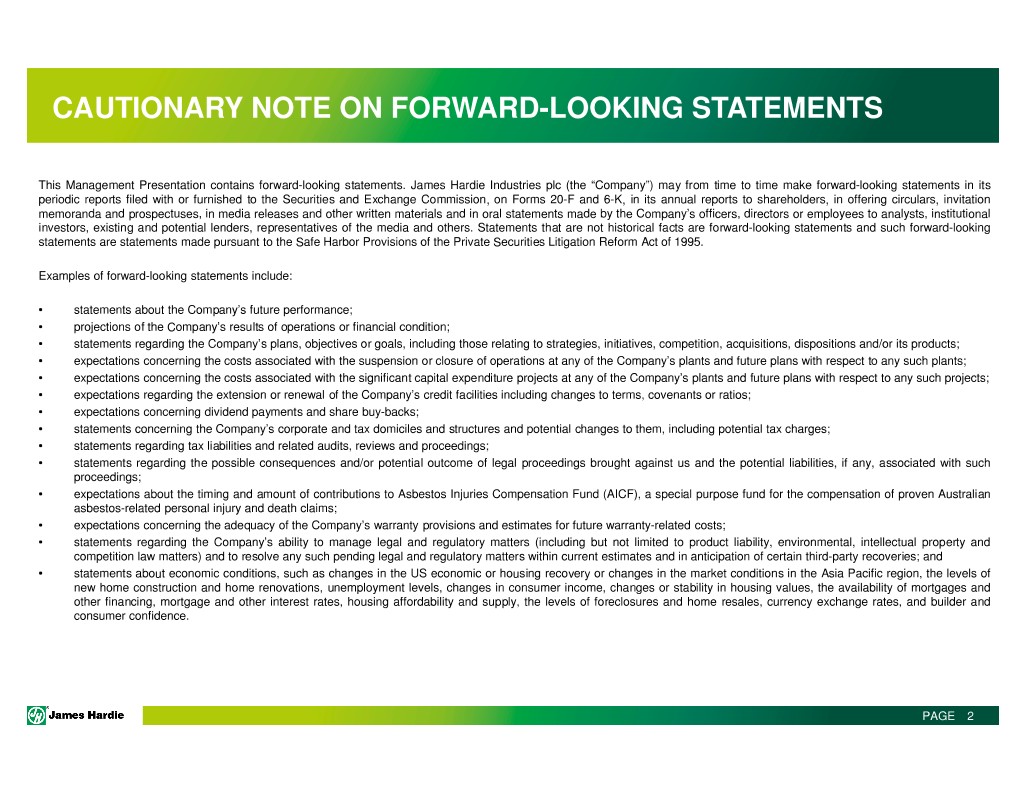
CAUTIONARY NOTE ON FORWARD-LOOKING STATEMENTS This Management Presentation contains forward-looking statements. James Hardie Industries plc (the “Company”) may from time to time make forward-looking statements in its periodic reports filed with or furnished to the Securities and Exchange Commission, on Forms 20-F and 6-K, in its annual reports to shareholders, in offering circulars, invitation memoranda and prospectuses, in media releases and other written materials and in oral statements made by the Company’s officers, directors or employees to analysts, institutional investors, existing and potential lenders, representatives of the media and others. Statements that are not historical facts are forward-looking statements and such forward-looking statements are statements made pursuant to the Safe Harbor Provisions of the Private Securities Litigation Reform Act of 1995. Examples of forward-looking statements include: • statements about the Company’s future performance; • projections of the Company’s results of operations or financial condition; • statements regarding the Company’s plans, objectives or goals, including those relating to strategies, initiatives, competition, acquisitions, dispositions and/or its products; • expectations concerning the costs associated with the suspension or closure of operations at any of the Company’s plants and future plans with respect to any such plants; • expectations concerning the costs associated with the significant capital expenditure projects at any of the Company’s plants and future plans with respect to any such projects; • expectations regarding the extension or renewal of the Company’s credit facilities including changes to terms, covenants or ratios; • expectations concerning dividend payments and share buy-backs; • statements concerning the Company’s corporate and tax domiciles and structures and potential changes to them, including potential tax charges; • statements regarding tax liabilities and related audits, reviews and proceedings; • statements regarding the possible consequences and/or potential outcome of legal proceedings brought against us and the potential liabilities, if any, associated with such proceedings; • expectations about the timing and amount of contributions to Asbestos Injuries Compensation Fund (AICF), a special purpose fund for the compensation of proven Australian asbestos-related personal injury and death claims; • expectations concerning the adequacy of the Company’s warranty provisions and estimates for future warranty-related costs; • statements regarding the Company’s ability to manage legal and regulatory matters (including but not limited to product liability, environmental, intellectual property and competition law matters) and to resolve any such pending legal and regulatory matters within current estimates and in anticipation of certain third-party recoveries; and • statements about economic conditions, such as changes in the US economic or housing recovery or changes in the market conditions in the Asia Pacific region, the levels of new home construction and home renovations, unemployment levels, changes in consumer income, changes or stability in housing values, the availability of mortgages and other financing, mortgage and other interest rates, housing affordability and supply, the levels of foreclosures and home resales, currency exchange rates, and builder and consumer confidence. PAGE 2
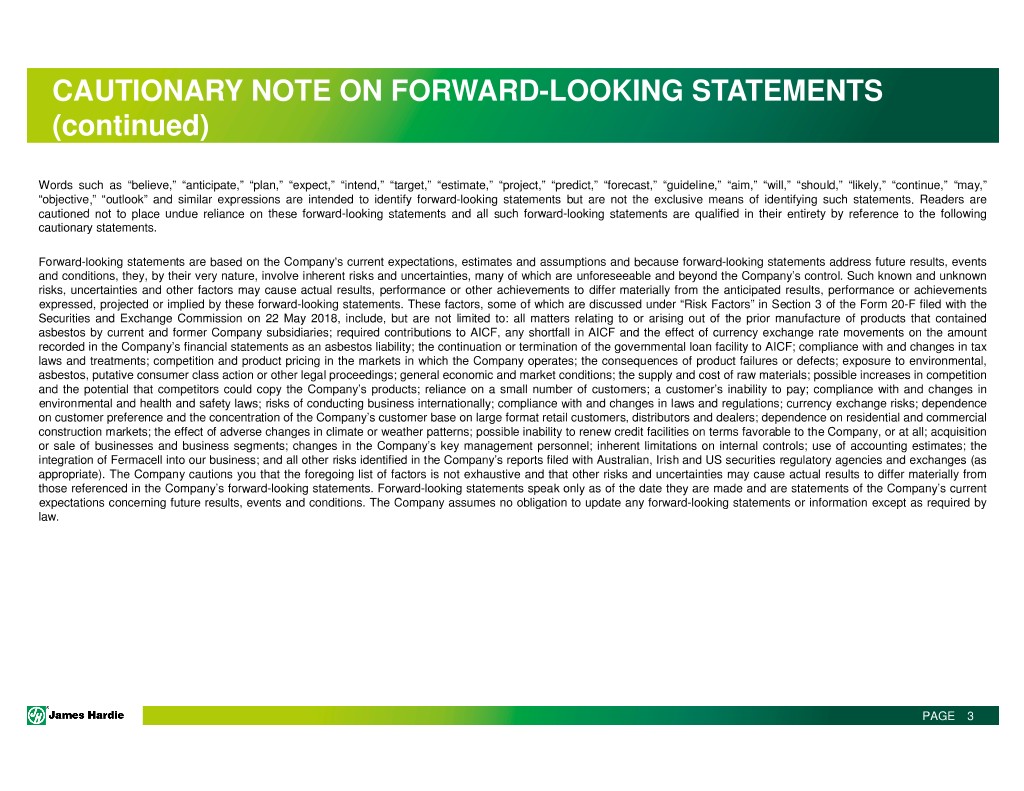
CAUTIONARY NOTE ON FORWARD-LOOKING STATEMENTS (continued) Words such as “believe,” “anticipate,” “plan,” “expect,” “intend,” “target,” “estimate,” “project,” “predict,” “forecast,” “guideline,” “aim,” “will,” “should,” “likely,” “continue,” “may,” “objective,” “outlook” and similar expressions are intended to identify forward-looking statements but are not the exclusive means of identifying such statements. Readers are cautioned not to place undue reliance on these forward-looking statements and all such forward-looking statements are qualified in their entirety by reference to the following cautionary statements. Forward-looking statements are based on the Company’s current expectations, estimates and assumptions and because forward-looking statements address future results, events and conditions, they, by their very nature, involve inherent risks and uncertainties, many of which are unforeseeable and beyond the Company’s control. Such known and unknown risks, uncertainties and other factors may cause actual results, performance or other achievements to differ materially from the anticipated results, performance or achievements expressed, projected or implied by these forward-looking statements. These factors, some of which are discussed under “Risk Factors” in Section 3 of the Form 20-F filed with the Securities and Exchange Commission on 22 May 2018, include, but are not limited to: all matters relating to or arising out of the prior manufacture of products that contained asbestos by current and former Company subsidiaries; required contributions to AICF, any shortfall in AICF and the effect of currency exchange rate movements on the amount recorded in the Company’s financial statements as an asbestos liability; the continuation or termination of the governmental loan facility to AICF; compliance with and changes in tax laws and treatments; competition and product pricing in the markets in which the Company operates; the consequences of product failures or defects; exposure to environmental, asbestos, putative consumer class action or other legal proceedings; general economic and market conditions; the supply and cost of raw materials; possible increases in competition and the potential that competitors could copy the Company’s products; reliance on a small number of customers; a customer’s inability to pay; compliance with and changes in environmental and health and safety laws; risks of conducting business internationally; compliance with and changes in laws and regulations; currency exchange risks; dependence on customer preference and the concentration of the Company’s customer base on large format retail customers, distributors and dealers; dependence on residential and commercial construction markets; the effect of adverse changes in climate or weather patterns; possible inability to renew credit facilities on terms favorable to the Company, or at all; acquisition or sale of businesses and business segments; changes in the Company’s key management personnel; inherent limitations on internal controls; use of accounting estimates; the integration of Fermacell into our business; and all other risks identified in the Company’s reports filed with Australian, Irish and US securities regulatory agencies and exchanges (as appropriate). The Company cautions you that the foregoing list of factors is not exhaustive and that other risks and uncertainties may cause actual results to differ materially from those referenced in the Company’s forward-looking statements. Forward-looking statements speak only as of the date they are made and are statements of the Company’s current expectations concerning future results, events and conditions. The Company assumes no obligation to update any forward-looking statements or information except as required by law. PAGE 3

AGENDA 1. JHS Strategy 2. Alignment to segmentation 3. Current market performance 4. HD construction methodology and PFW 5. Why Ritek? 6. JHS Performance PAGE 4
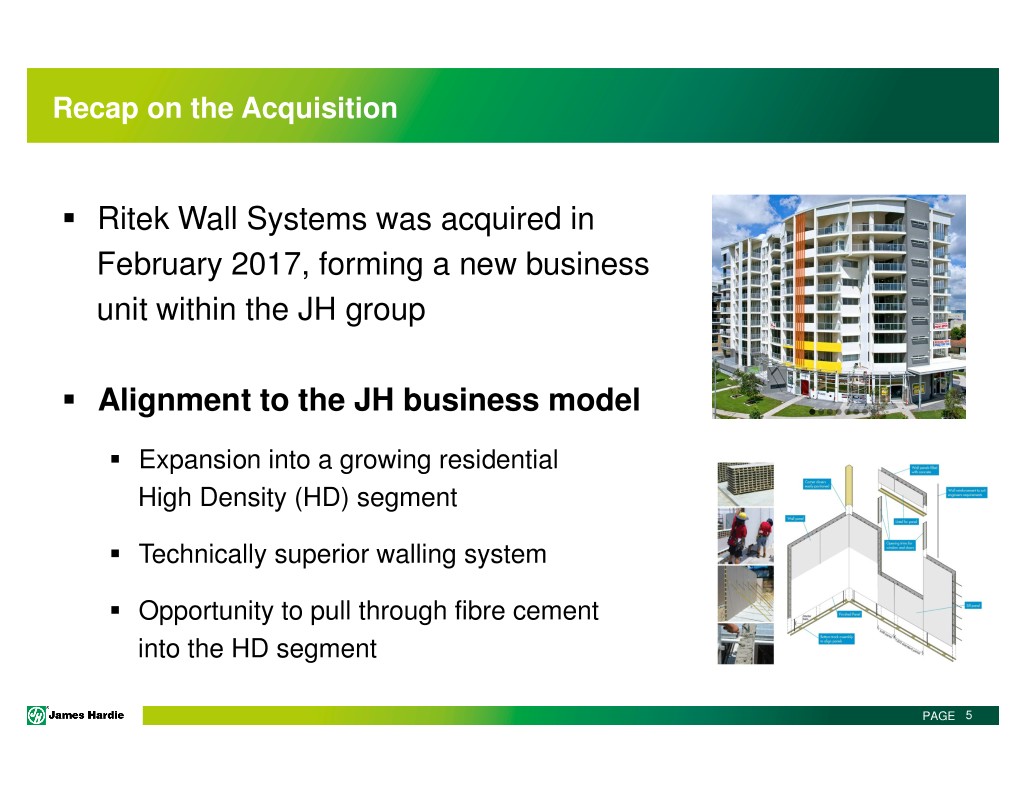
Recap on the Acquisition Ritek Wall Systems was acquired in February 2017, forming a new business unit within the JH group Alignment to the JH business model Expansion into a growing residential High Density (HD) segment Technically superior walling system Opportunity to pull through fibre cement into the HD segment PAGE 5
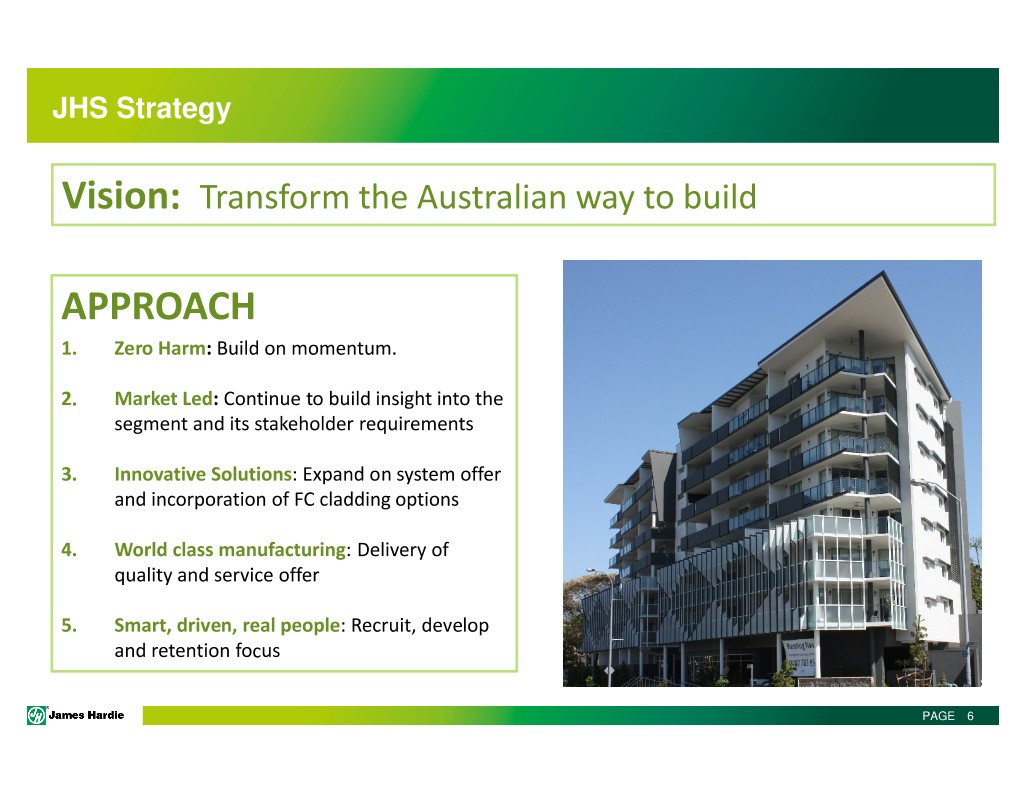
JHS Strategy Vision: Transform the Australian way to build APPROACH 1. Zero Harm : Build on momentum. 2. Market Led : Continue to build insight into the segment and its stakeholder requirements 3. Innovative Solutions : Expand on system offer and incorporation of FC cladding options 4. World class manufacturing : Delivery of quality and service offer 5. Smart, driven, real people : Recruit, develop and retention focus PAGE 6
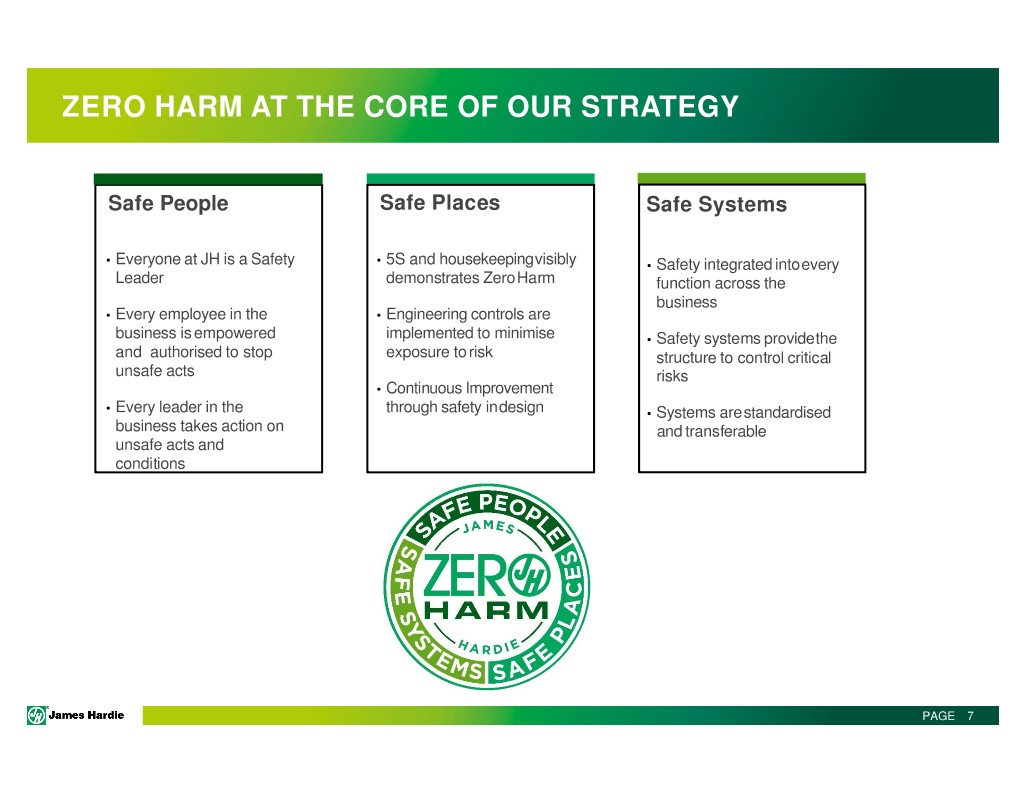
ZERO HARM AT THE CORE OF OUR STRATEGY Safe People Safe Places Safe Systems • Everyone at JH is a Safety • 5S and housekeepingvisibly • Safety integrated intoevery Leader demonstrates ZeroHarm function across the business • Every employee in the • Engineering controls are business is empowered implemented to minimise • Safety systems providethe and authorised to stop exposure to risk structure to control critical unsafe acts risks • Continuous Improvement • Every leader in the through safety indesign • Systems arestandardised business takes action on and transferable unsafe acts and conditions PAGE 7

Aligning with the organisations Zero Harm culture Example of improvements within mobile plant interaction PAGE 8
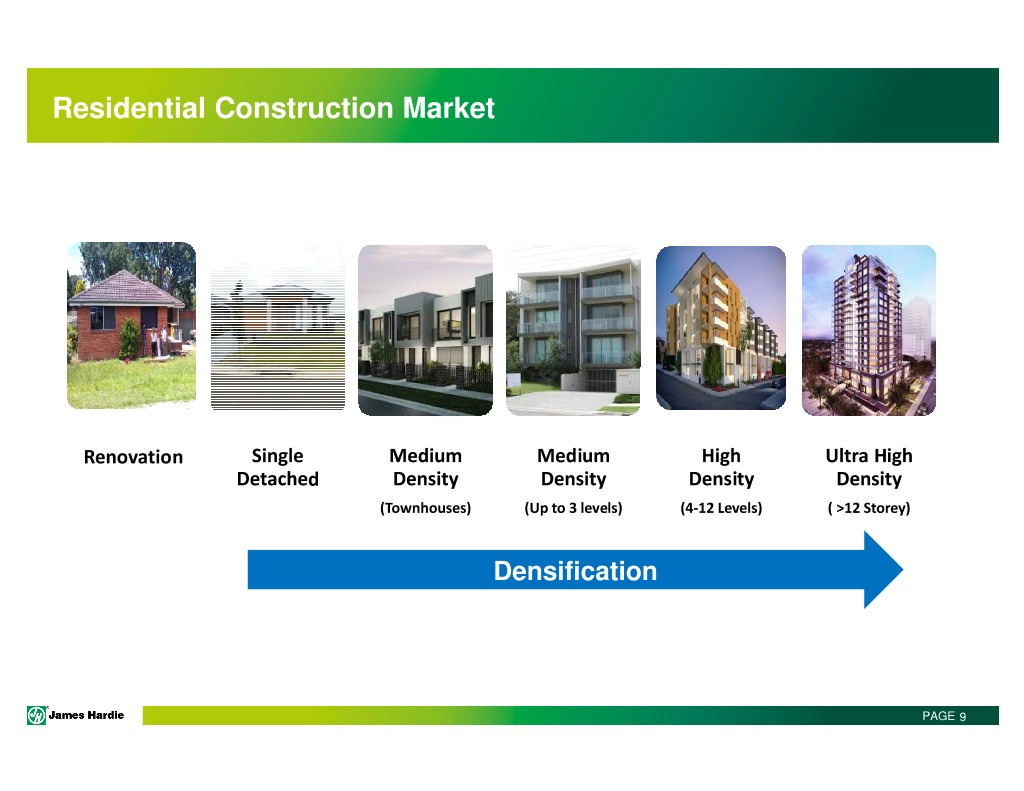
Residential Construction Market Renovation Single Medium Medium High Ultra High Detached Density Density Density Density (Townhouses) (Up to 3 levels) (4-12 Levels) ( >12 Storey) Densification PAGE 9
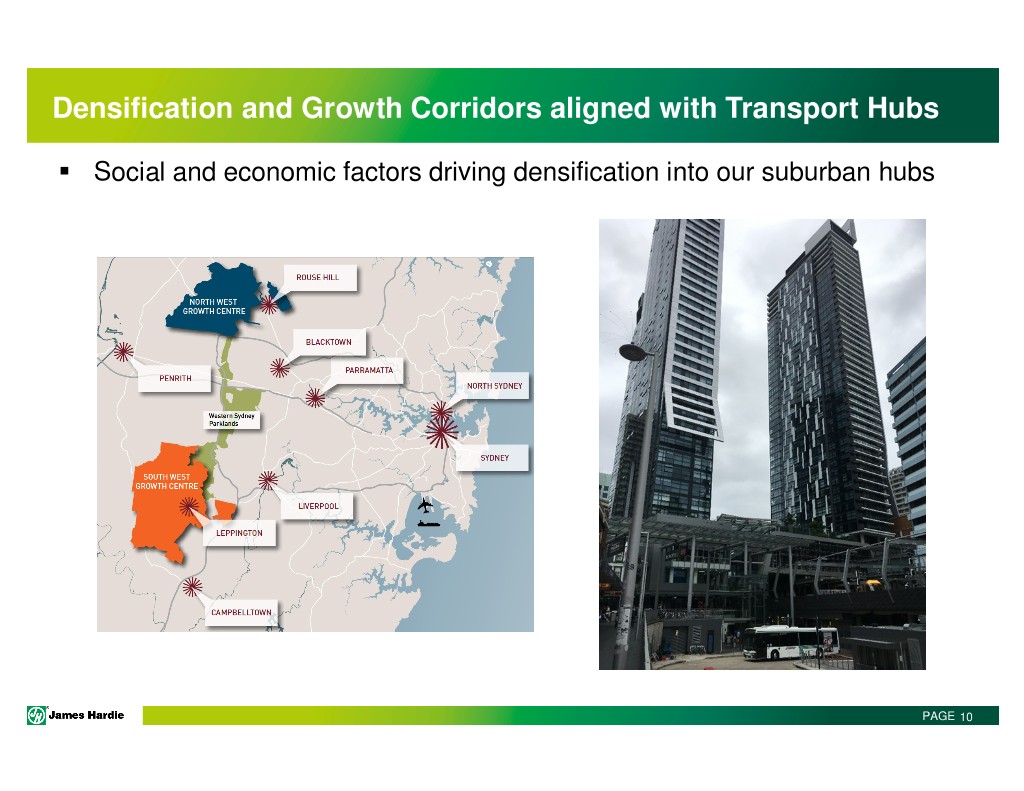
Densification and Growth Corridors aligned with Transport Hubs Social and economic factors driving densification into our suburban hubs PAGE 10
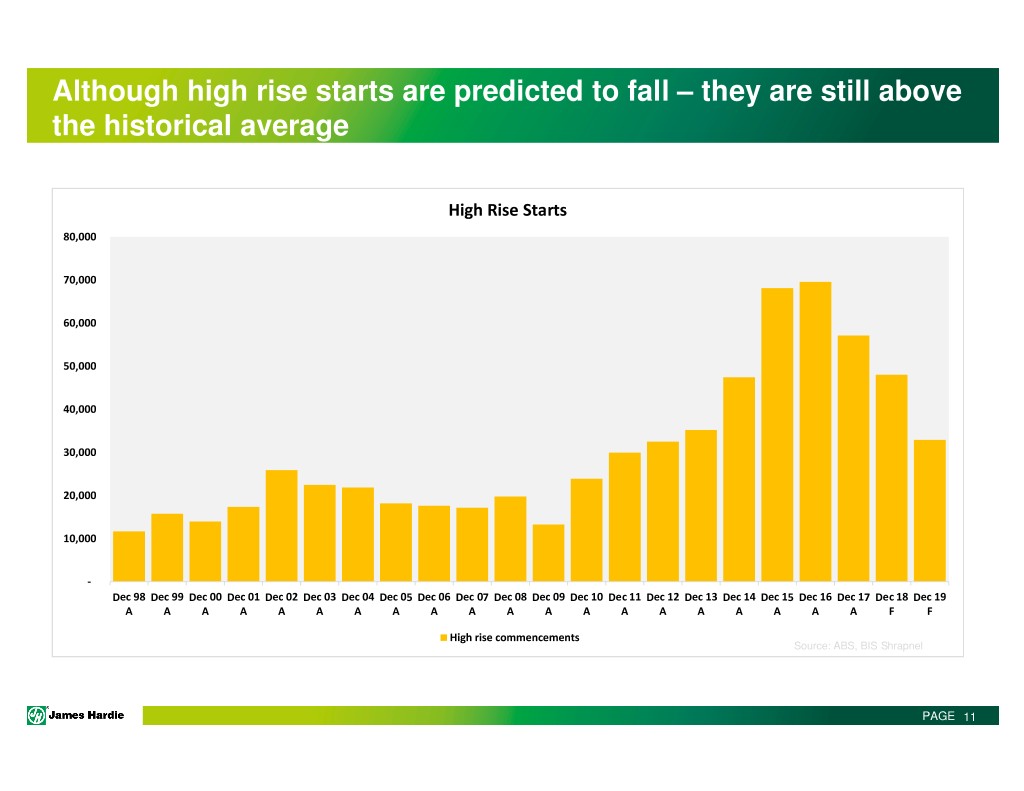
Although high rise starts are predicted to fall – they are still above the historical average High Rise Starts 80,000 70,000 60,000 50,000 40,000 30,000 20,000 10,000 - Dec 98 Dec 99 Dec 00 Dec 01 Dec 02 Dec 03 Dec 04 Dec 05 Dec 06 Dec 07 Dec 08 Dec 09 Dec 10 Dec 11 Dec 12 Dec 13 Dec 14 Dec 15 Dec 16 Dec 17 Dec 18 Dec 19 A A A A A A A A A A A A A A A A A A A A F F High rise commencements Source: ABS, BIS Shrapnel PAGE 11

Moreover the pipeline of work remaining is large High Rise Pipeline 35000 30000 The pipeline consists of both: 25000 1. Value of work 20000 yet to be done 15000 2. Value of work Value of Pipeline ($m) Pipelineof Value yet to be 10000 commenced 5000 0 Sep-01 Sep-02 Sep-03 Sep-04 Sep-05 Sep-06 Sep-07 Sep-08 Sep-09 Sep-10 Sep-11 Sep-12 Sep-13 Sep-14 Sep-15 Sep-16 Sep-17 Mar-02 Mar-03 Mar-04 Mar-05 Mar-06 Mar-07 Mar-08 Mar-09 Mar-10 Mar-11 Mar-12 Mar-13 Mar-14 Mar-15 Mar-16 Mar-17 Source: ABS NSW VIC QLD Other PAGE 12
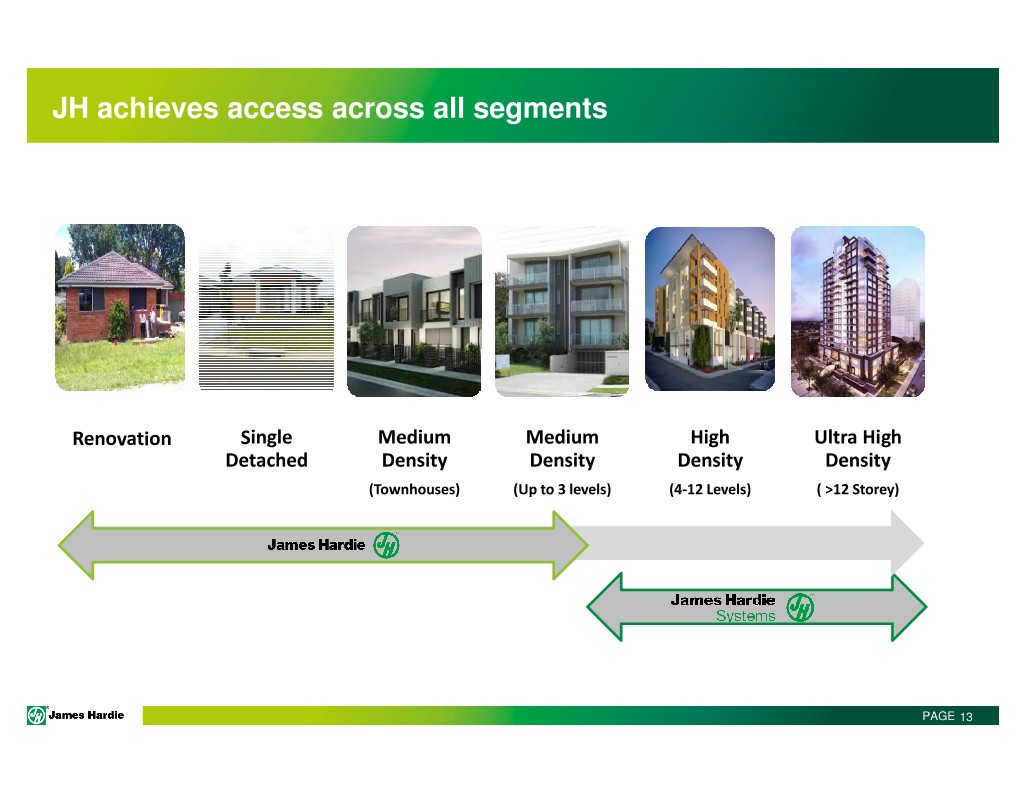
JH achieves access across all segments Renovation Single Medium Medium High Ultra High Detached Density Density Density Density (Townhouses) (Up to 3 levels) (4-12 Levels) ( >12 Storey) PAGE 13
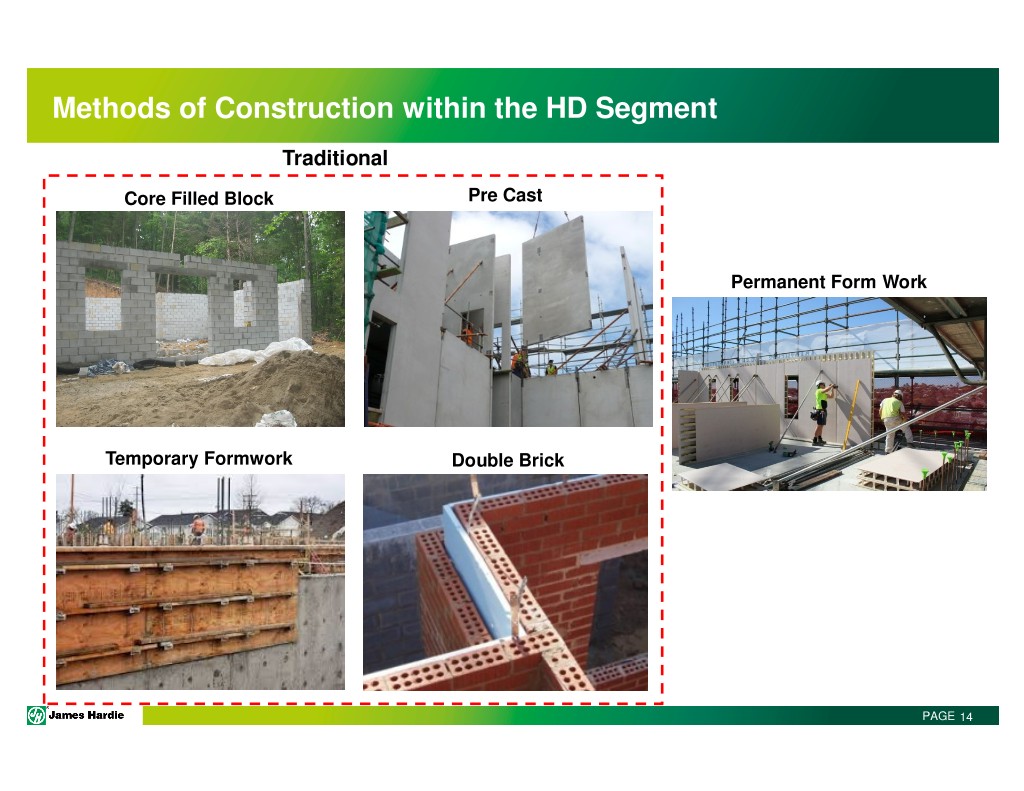
Methods of Construction within the HD Segment Traditional Core Filled Block Pre Cast Permanent Form Work Temporary Formwork Double Brick PAGE 14

Permanent Formwork (PFW) What is PFW? PFW is a structural walling system that consists of braces or moulds, put in place to contain concrete as it sets, however not removed after the fact. PAGE 15
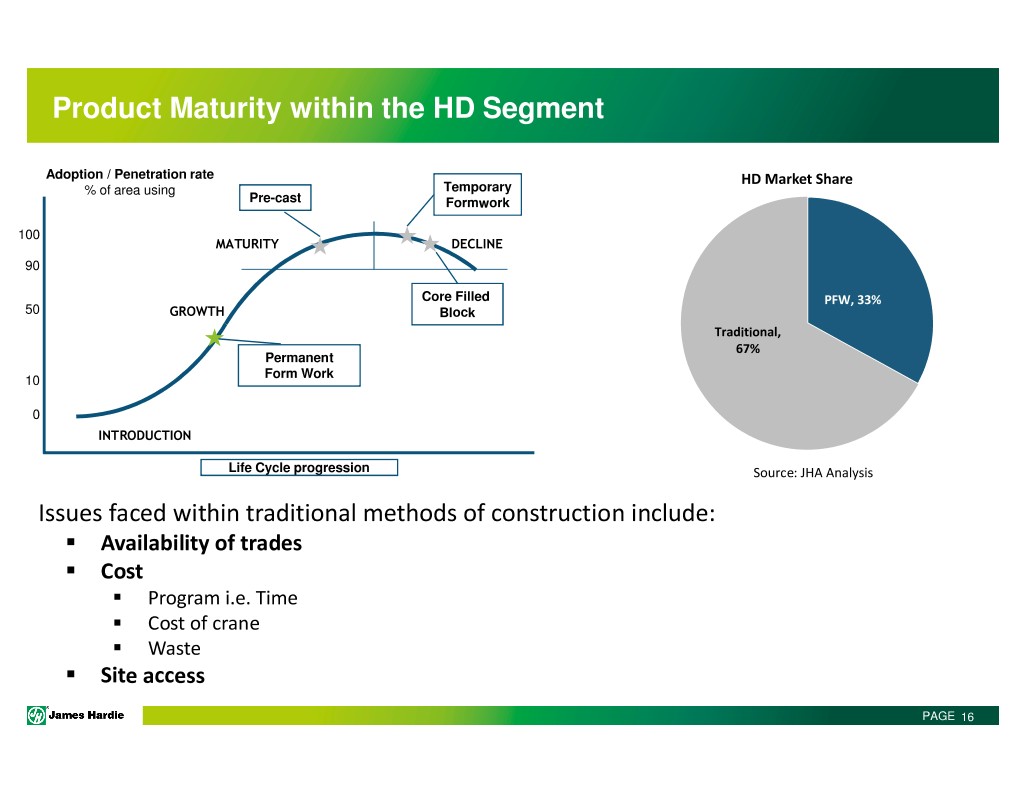
Product Maturity within the HD Segment Adoption / Penetration rate HD Market Share % of area using Temporary Pre-cast Formwork 100 MATURITY DECLINE 90 Core Filled PFW, 33% 50 GROWTH Block Traditional, 67% Permanent Form Work 10 0 INTRODUCTION Life Cycle progression Source: JHA Analysis Issues faced within traditional methods of construction include: Availability of trades Cost Program i.e. Time Cost of crane Waste Site access PAGE 16
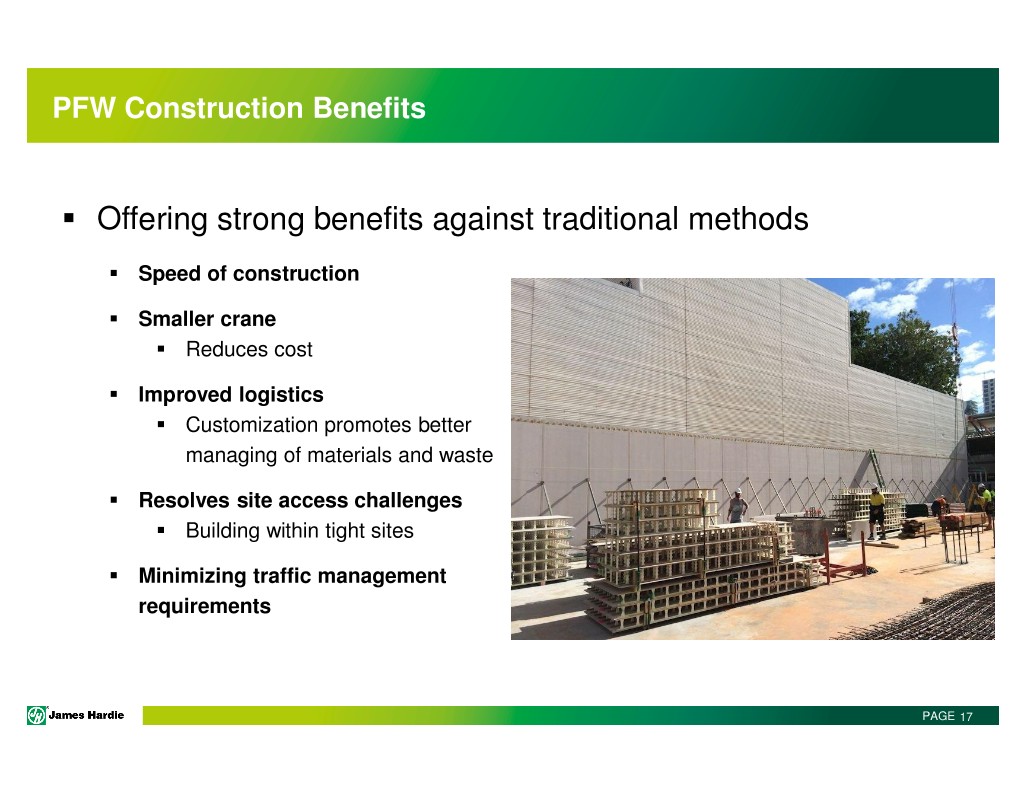
PFW Construction Benefits Offering strong benefits against traditional methods Speed of construction Smaller crane Reduces cost Improved logistics Customization promotes better managing of materials and waste Resolves site access challenges Building within tight sites Minimizing traffic management requirements PAGE 17
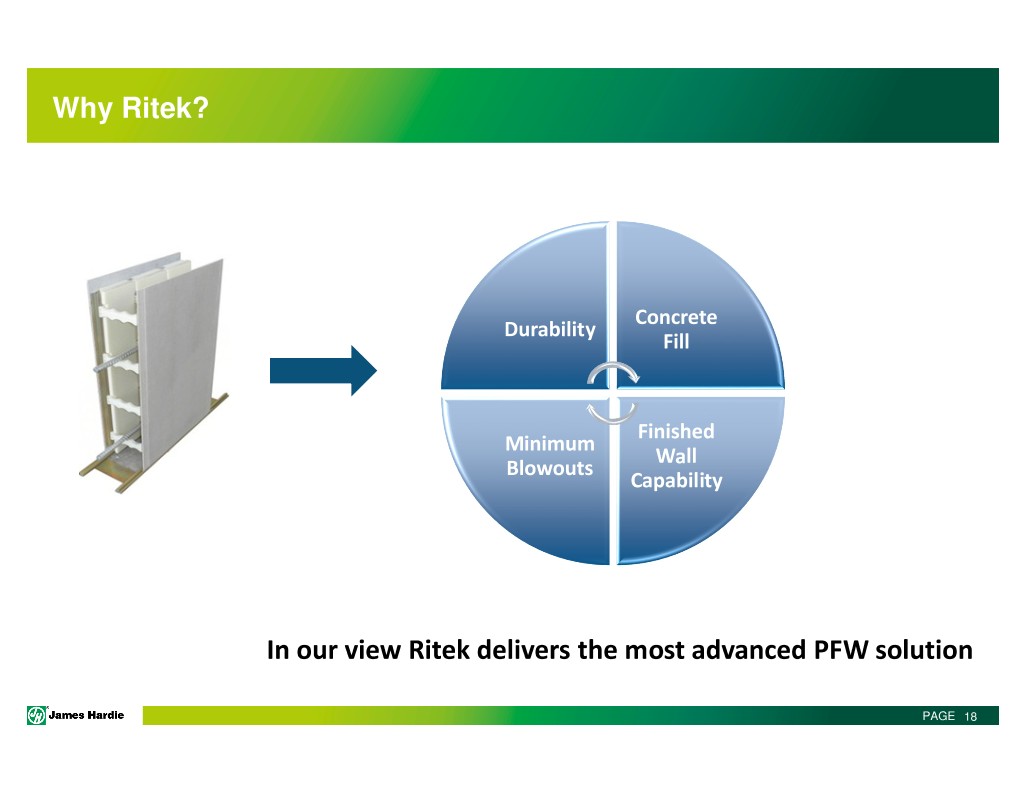
Why Ritek? Concrete Durability Fill Finished Minimum Wall Blowouts Capability In our view Ritek delivers the most advanced PFW solution PAGE 18
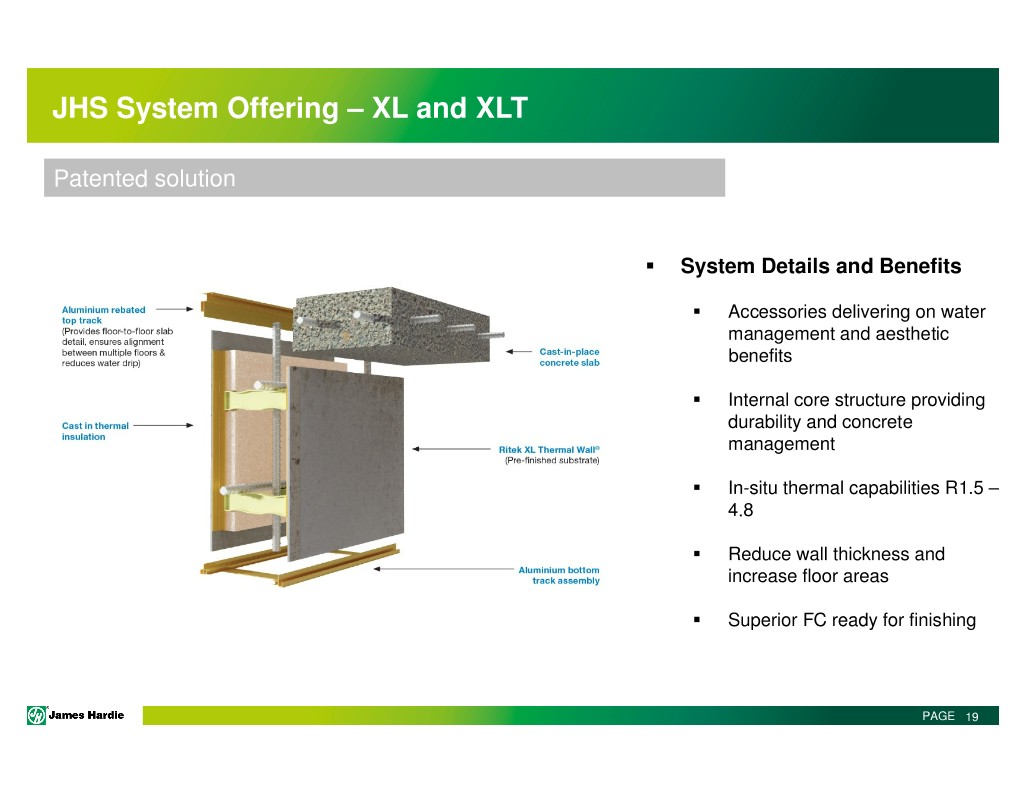
JHS System Offering – XL and XLT Patented solution System Details and Benefits Accessories delivering on water management and aesthetic benefits Internal core structure providing durability and concrete management In-situ thermal capabilities R1.5 – 4.8 Reduce wall thickness and increase floor areas Superior FC ready for finishing PAGE 19
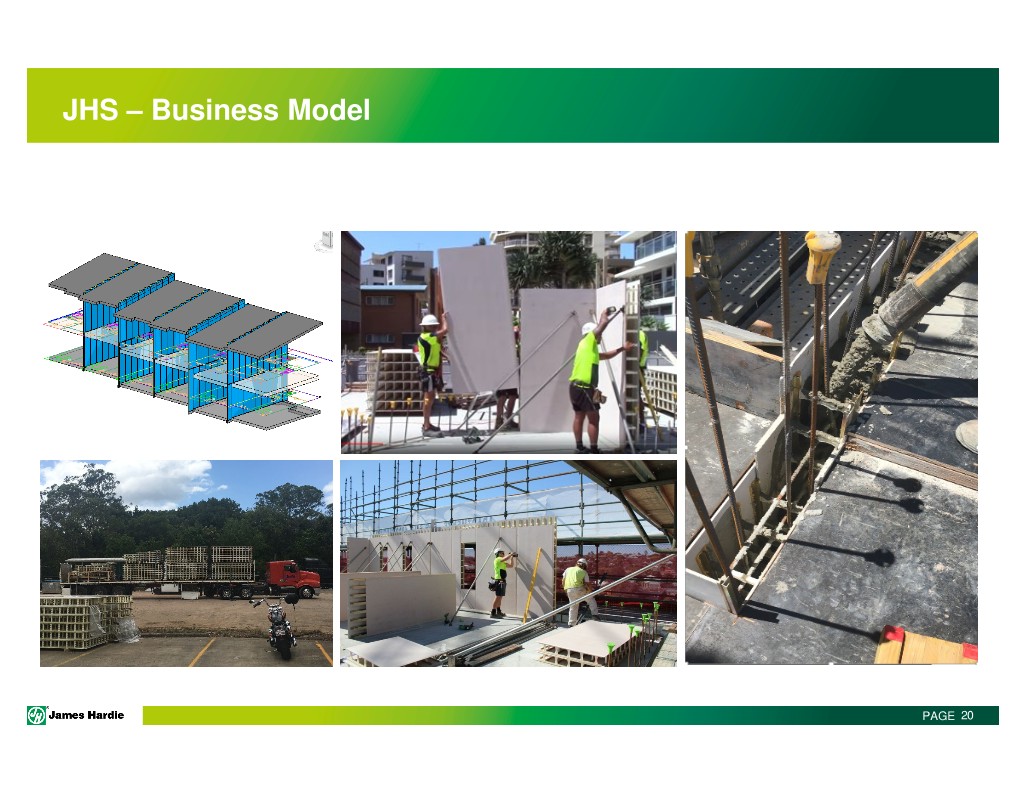
JHS – Business Model PAGE 20

JHS System Applications Exterior Interior Blade Walls Lift Shafts Stair Wells Columns PAGE 21
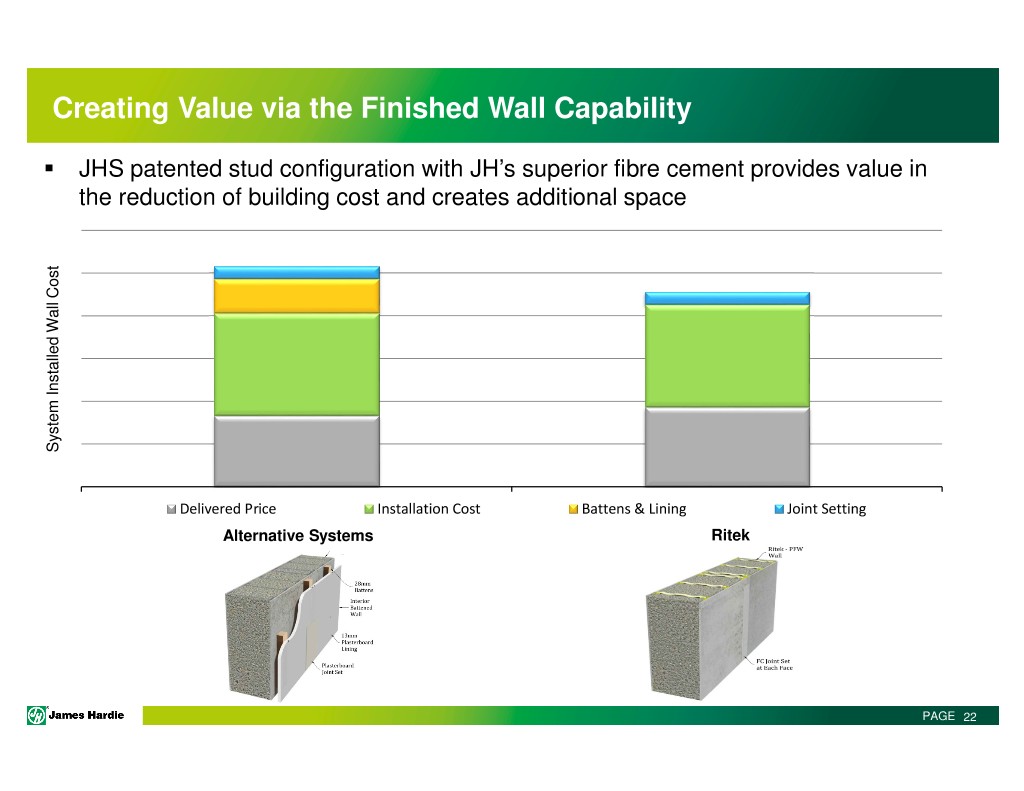
Creating Value via the Finished Wall Capability JHS patented stud configuration with JH’s superior fibre cement provides value in the reduction of building cost and creates additional space System Installed Wall Cost Wall Installed System Delivered Price Installation Cost Battens & Lining Joint Setting Alternative Systems Ritek PAGE 22
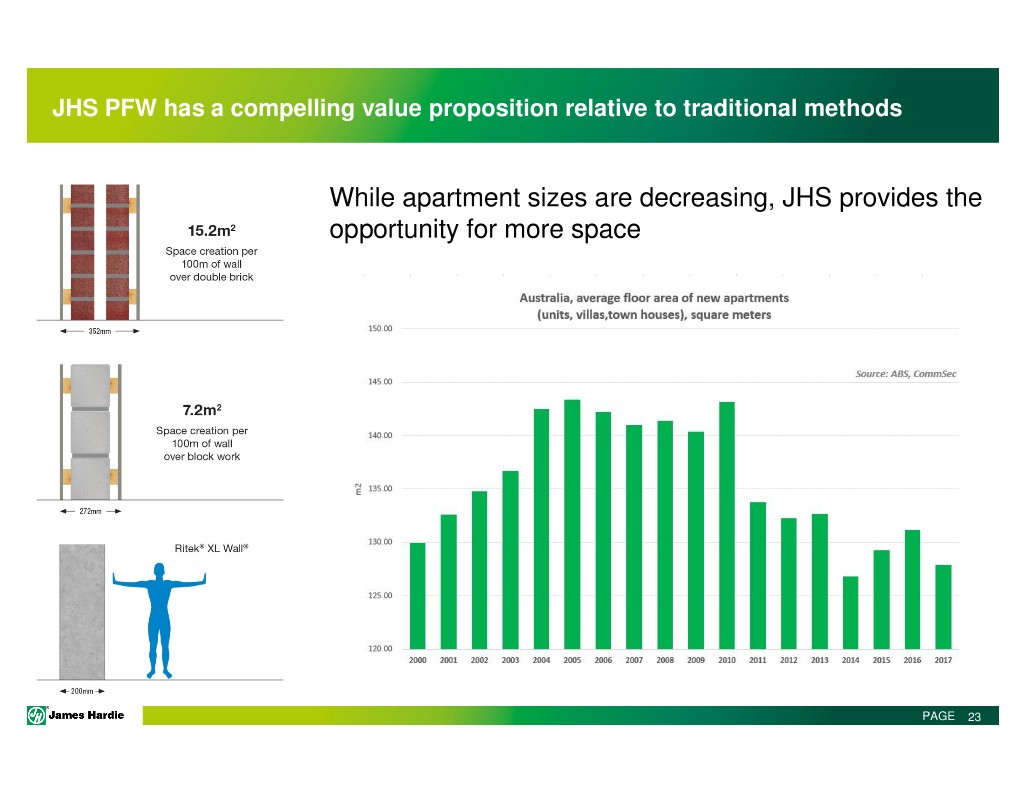
JHS PFW has a compelling value proposition relative to traditional methods While apartment sizes are decreasing, JHS provides the opportunity for more space PAGE 23
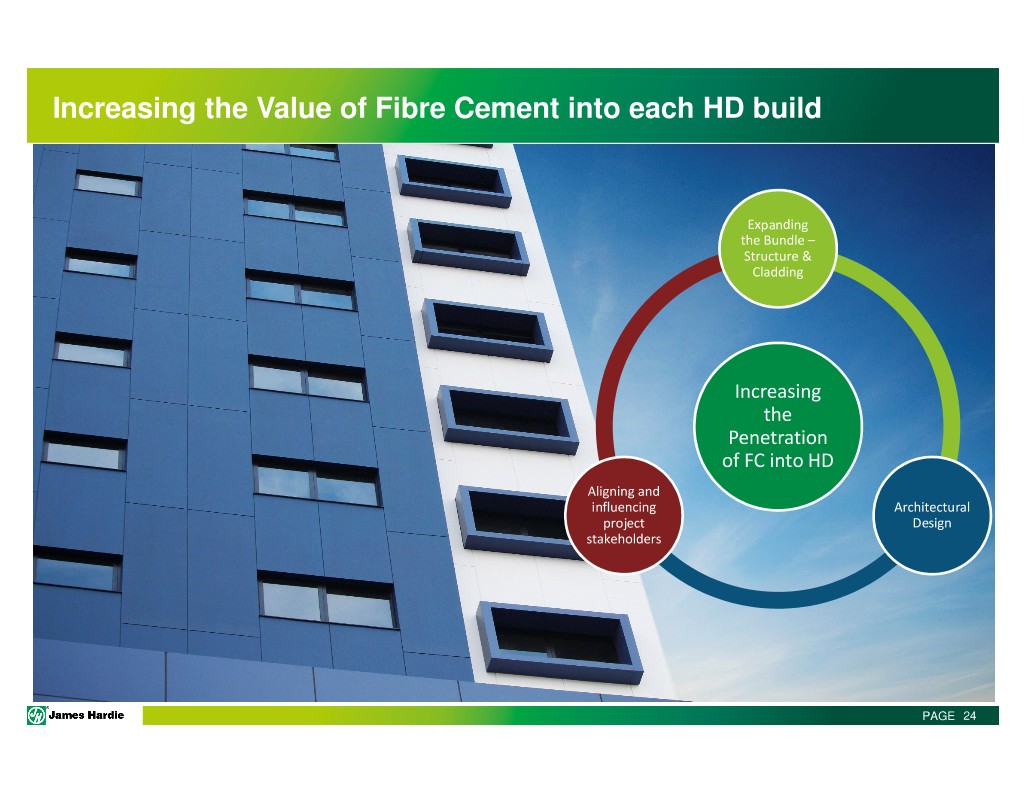
Increasing the Value of Fibre Cement into each HD build Expanding the Bundle – Structure & Cladding Increasing the Penetration of FC into HD Aligning and influencing Architectural project Design stakeholders PAGE 24

Increasing fibre cement penetration into the HD segment Enabling a fibre cement bundle within the HD segment while providing the opportunity to differentiate the look PAGE 25
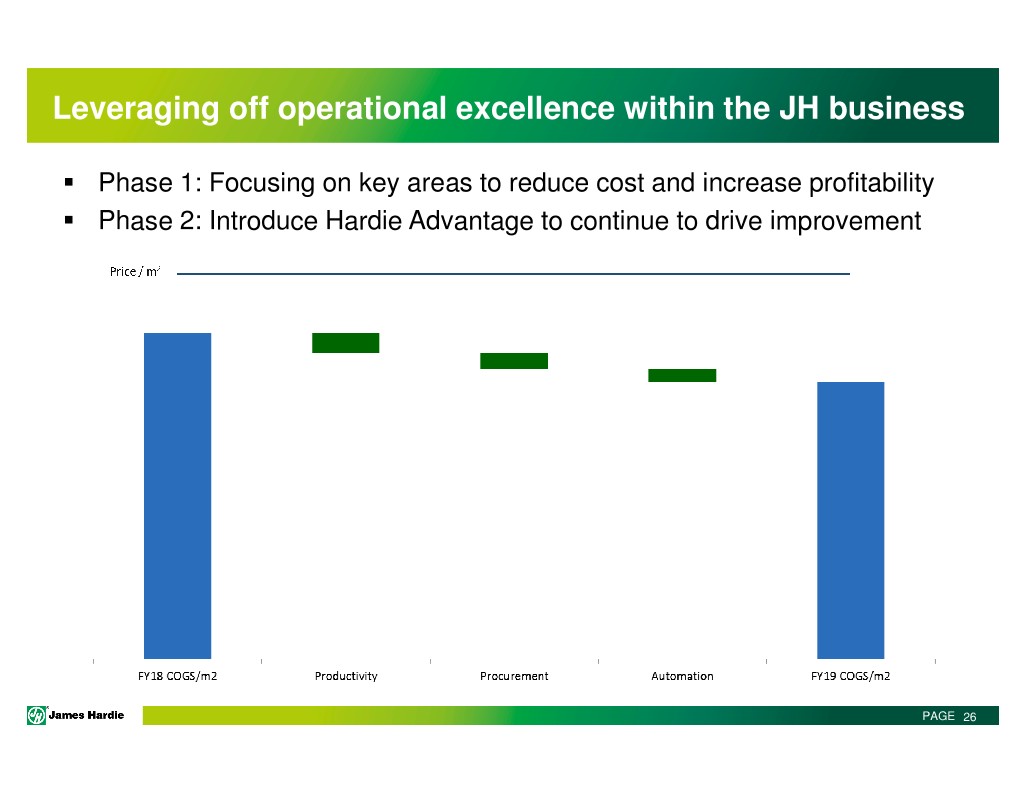
Leveraging off operational excellence within the JH business Phase 1: Focusing on key areas to reduce cost and increase profitability Phase 2: Introduce Hardie Advantage to continue to drive improvement PAGE 26
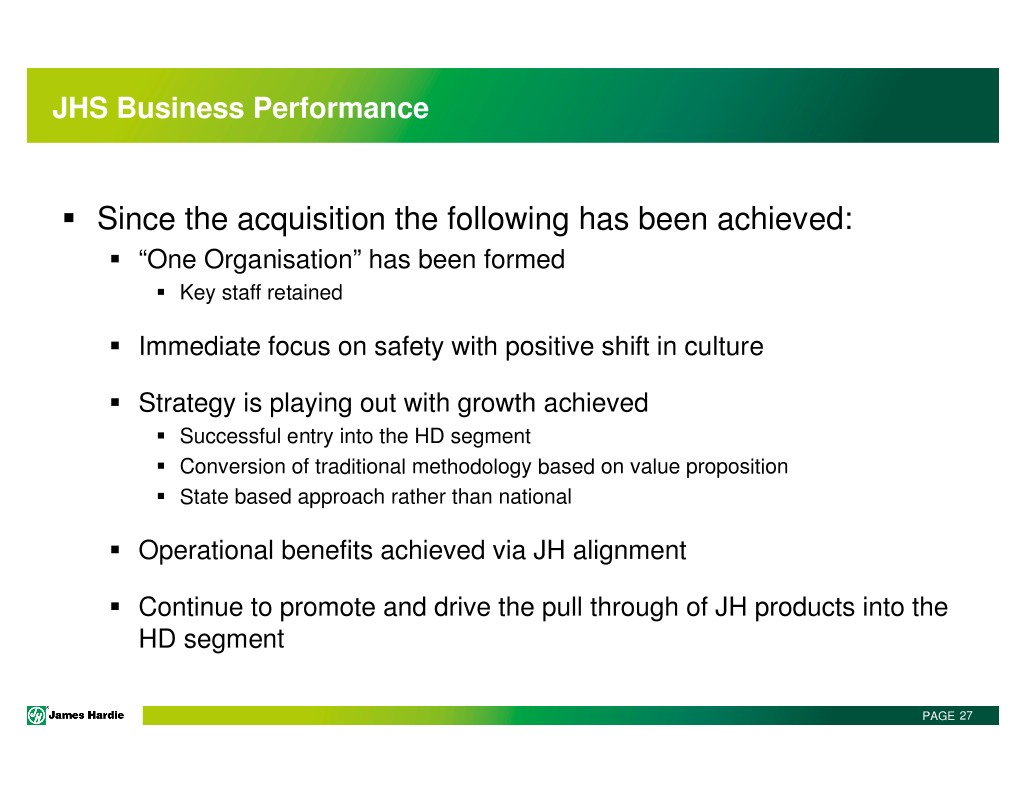
JHS Business Performance Since the acquisition the following has been achieved: “One Organisation” has been formed Key staff retained Immediate focus on safety with positive shift in culture Strategy is playing out with growth achieved Successful entry into the HD segment Conversion of traditional methodology based on value proposition State based approach rather than national Operational benefits achieved via JH alignment Continue to promote and drive the pull through of JH products into the HD segment PAGE 27

JHS Strategy Vision: Transform the Australian way to build APPROACH 1. Zero Harm : Build on momentum. 2. Market Led : Continue to build insight of the segment and its stakeholder requirements 3. Innovative Solutions : Expand on system offer and incorporation of FC cladding options 4. World class manufacturing : Delivery of quality and service offer 5. Smart, driven, real people : Recruit, develop and retention focus PAGE 28
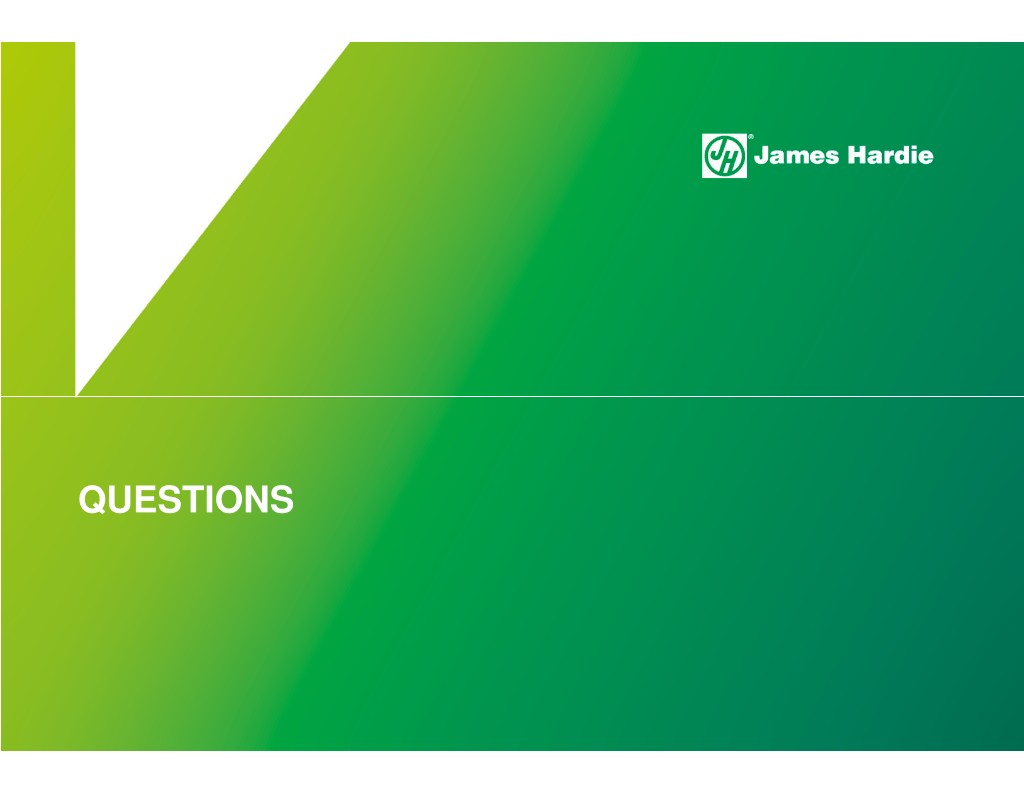
QUESTIONS